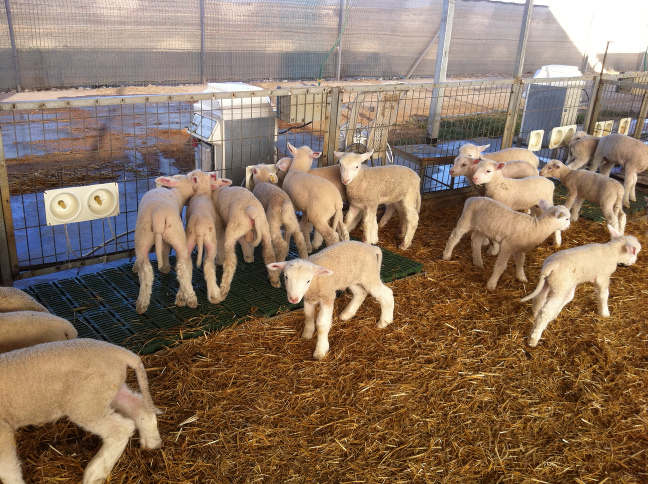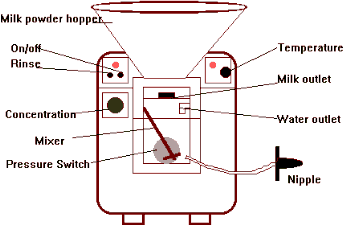Lamb
BIOTIC AUTOMATIC LAMB FEEDERS
Biotic’s automatic LACTEK provide an effective solution for large and small-scale lamb farming. Biotic feeders help support the healthy development of lambs through a system that supports their natural feeding instincts – while saving time, reducing costs, and improving lamb viability.

Increased Milk Yield
Research shows that the early removal of lambs (within 12 hours) from a milking herd can increase milk yield by 30-40%.
• Biotic automatic LACTEK support the early removal of lambs from milking herds by providing a feeding solution that seamlessly supports a lamb’s natural feeding instinct.
Stronger, More Viable Lambs
Biotic automatic LACTEK offer a smart solution for feeding lambs in large litters (3-4) that may exceed the ewe’s ability to raise them. Our feeders also provide a solution for breeding herds where valuable lambs may be orphaned or ewes unable to produce milk. Biotic automatic lamb feeders offer the benefit of natural feeding, including:
• Continuous milk access gives lambs ability to feed at will according to their natural instinct.
• Adjustable milk/powder ratio (strength of milk adaptable) allows weight and health monitoring for each lamb, and supports natural weaning process.
• LACTEK feeder let lambs feed at their own frequency and volume according to their natural instinct.
• Biotic feeders help ensure lambs move around freely, resulting in animals with better muscular development, form and meat quality.
• Biotic feeders support healthy lamb development by allowing lambs to drink warmed milk by means of a nipple – supporting the instinctive suckling action critical to normal digestive functioning, nutritional absorption, and overall health.
• Biotic LACTEK allow monitoring and reports on individual lamb milk consumption – offering valuable insight on lamb health and development.
Through respect for the animals' natural behavior, this method offers spectacular results unequaled by any other raising system.

Reduces Labor, Increases Efficiency, Saves on Costs
Biotic’s automatic LACTEK provide an on-demand feeding system that saves time, reduces manual labor and generates cost savings.
• Each feeder supports as many as 80 lambs or as few as 3 or 4, and training lambs to use the feeder is quick and simple.
• No mixing by hand – Biotic feeders are fully automatic.
• Significantly reduces labor costs & saves time – Biotic feeders automatically manage feeding with minimal manual labor required. Just five minutes per day for cleaning and monitoring are needed.
• Install anywhere – LACTEK can be located in any type of building and only need connections to electricity and running water.
• Decreases product cost – LACTEK help eliminate excess product waste and decrease product cost by mixing only the amount of milk or milk replacer necessary for each animal.
Click here to see our Automatic Lamb Feeder products.
Lamb management Research in France and elsewhere has led to the following procedures for lambs rearing where the objective has been to achieved maximum growth rates.
(The procedure are complementary to other methods designed for control of reproduction in intensive lamb production.)
Lambs are removed from the ewes between 24 and 48 hours after birth, care being taken to ensure that lambs received colostrum. Lambs are maintained in groups up to 25 per pen . They are placed in the nursery late in the day and fasted throughout the night. The next day, they are trained to drink from the feeder. On average this will require one or two try. During the following days lambs are checked to see if all are drinking milk.
Lambs can be reared in any kind of building as long as it has a good draining system and it is draft free. About 5 to 8 square feet per lambs is required. Straw is the best bedding and should be abundant and dry.
Milk replacer
It should be of good quality and formulated specially for lambs. The milk/water ratio should be such that it provide milk of a dry matter content of 16% , similar to ewe's milk, with 25% of crude protein ant a total of fat of 24%. Two third of the fat is animal origin ( i.e. refined tallow) and one third vegetable origin. Lambs stay on the feeder for 45 days to weaning.
Weaning procedure
It is important to ensure that lambs are fully adapted to dry feed consumption. The lambs are gradually introduced to hay and dry feed concentrate (16% protein ) from the tenth day. Water is provided from the 20th day, after which the concentrate diet is change to one of 14% protein design for fattening.
Result
(Extract From Wool Technology and Sheep Breeding, Australia,12/82. Experiment was done to evaluate this method : twin born lambs (Merino cross lambs) were assigned at random to two groups, one reared artificially in the nursery , the other on their mother under pasture condition):
"The result show that the artificially reared lambs grew slightly faster than the other, up to the end of the milk phase (45 days). The artificially reared lambs gained approximately 320 gram(11 oz) per head per day to 39 days of age. This performance equals the best weight gains recorded in France. When compared again at 150 days the artificially reared lambs had similar live-weight to their naturally reared counterparts. It is important to note that these were drawn from triplet, quad and quintuplet litters whose birth weights were as low as 1.2 kg. (2.66 lb.). The lambs, even with low birth weight , adapted readily to the nipple and in no case have we eliminated lambs from the nursery for failure to drink. The lambs from large litters would have died if left with the ewe, even under special management condition ( lambing indoors, supplement feeding of ewes and lambs). Their growth rate were clearly satisfactory and were equal to their naturally reared littermates."

